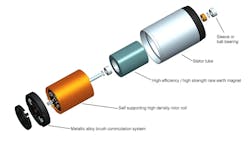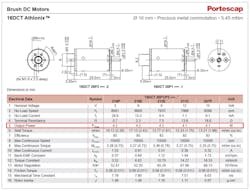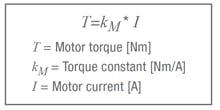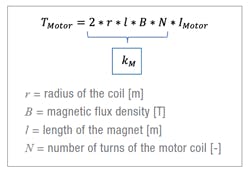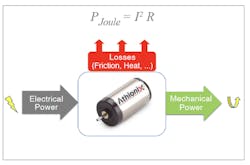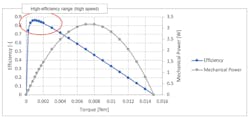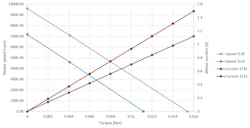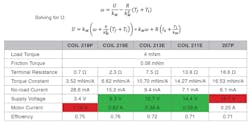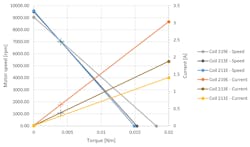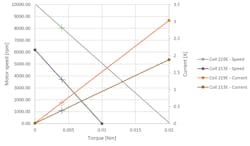DC Motor Coil Selection: Look at the Required Working Point and Power Supply
DC motors come in many forms, but they all have the same job: turning electrical energy (DC) into mechanical energy. Although DC motors have a common operating principle, many applications—including portable medical devices like infusion pumps—require one that performs this task with the highest efficiency to achieve a long, reliable service life. This is typically where an ironless DC motor comes in.
Consider, for example, a motor that is required to operate continuously at approximately 7,000 rpm with 4 mNm torque. It must also deliver 2.9 W continuous power. A Portescap 16DCT Athlonix ironless DC motor with precious metal commutation is a good fit in this example, because it supports a maximum continuous power of up to 4.2 W (Fig. 2). Since this motor can provide the necessary continuous power, the designer only has to select the motor coil. To choose the right motor coil, keep these two key points in mind:
- The maximum continuous torque of a DC motor depends on the motor’s heat dissipation capability and therefore mainly on its dimensions. Changing the coil of a DC motor will not impact its maximum continuous torque.
- Changing the coil makes it possible to adapt the motor to the available power supply voltage and current to create an efficient motor system.
Understanding the important formulae involved in selecting a DC motor coil will help engineers and designers understand how power supplies impact coil selection in various scenarios.
Theory Review
Torque:
The torque produced by a DC motor can be described by the following relationship: The output torque produced is equal to the torque constant of the motor multiplied by the current consumed.
If we further develop the torque constant to its basic dependency, we can represent the same formula as:
Parameters “r,” “I” and “B” depend on the chosen motor and its dimensions. Therefore, to design different coils with different torque constants, the number of coil turns “N” is varied.
Speed:
Rotational speed of a DC motor can be described by the following relationship:
When looking at a specific motor size (for example, 16-mm diameter and 25-mm length), the motor regulation factor R/kM2 is constant across different coils. Neglecting friction, the no-load speed ω() of the motor is defined by the available supply voltage and the torque constant of the coil.
The preceding example clearly shows why suppliers offer a selection of typically different coils for a specific motor. All coils shown are able to achieve the same working point—5,500 rpm and a torque of 5 mNm in this example—but with different supply voltages and current requirements. The coil is therefore chosen to adapt the motor to the available power supply.
Efficiency and Mechanical Power:
The efficiency is defined as the mechanical power output divided by the electrical power input:
Besides friction, part of the electrical power will always be lost mainly due to heat created by the current running through the copper wire of the coil. These heat losses are called Joule losses, and they are proportional to the coil resistance multiplied by the square of the current.
To achieve high efficiency, create the maximum mechanical power at the lowest possible Joule losses. This can be accomplished by operating the motor at a high speed and low torque, as shown in Fig. 5.
Although the mechanical power of a DC motor is greatest when used at half of its stall torque, its efficiency is much higher at lower torque due to the lower motor current and, therefore, lower Joule losses. In order to use the motor at the highest possible speed and efficiency, motor coil selection is critical.
Choose the Right Coil Based on Available Catalog Coils
When identifying the right motor, you may not always have the option of customizing the coil. Developing a new coil requires a time and money investment by both the customer and the motor manufacturer. Therefore, this first selection will focus on choosing the right coil from available catalogs.
Scenario 1: Voltage Source Power Supply
Using the same example as in the introduction, but also considering the available power supply and using as an example Portescap 16DCT Athlonix ironless DC with maximum continuous output power of 4.2 W, we have:
- Working point: continuous operation around 7,000 rpm at a torque of 4 mNm, equal to 2.9 W.
- Available power supply: voltage source with 10.8 V fixed voltage.
Coil 213E and coil 211E appear to be reasonable choices, since they are both designed to operate at approximately 8,000 rpm at 9 V and 12 V respectively. The motor speed and current at the working point with a 10.8 V supply voltage can be calculated using the formula provided in the introduction and the coil specifications shown in the datasheet:
Considering the available power supply and load torque, only coil 213E can reach a speed higher than 7,000 rpm. With a voltage source, there’s only one close match for selecting a catalog coil. To optimize the motor with the best possible coil, a current source is required.
Scenario 2: Current Source Power Supply
In this scenario, a current source is available—instead of a voltage source—to achieve the same working point:
- Working point: continuous operation around 7,000 rpm at a torque of 4 mNm, equal to 2.9 W.
- Available power supply: current source, with 1A maximum continuous current available from 1 to 15 V.
The available current source can provide 1 A maximum continuous, within a voltage range of 1 to 15 V. The supply voltage is flexible, so a much wider range of available catalog coils can be considered to achieve the working point. The required voltage to reach the working point at 7,000 rpm and 4 mNm can be calculated using the formula introduced in the Theory Review section of this article. As with the first scenario, the current required to reach the working point is calculated in two-second steps.
Both coils 219P and 207 are eliminated because they require, respectively, a voltage and a current outside the available range. If total efficiency is your criterion, coil 219E is the most efficient of the three remaining coils. However, in most cases the coil with the lowest current consumption provides the best choice. Lower current consumption yields a longer lifetime for the commutation system and increases the number of cycles with a single battery charge for battery powered applications.
In this scenario with a current source power supply, coil 211E draws almost half the current compared to coil 219E and therefore provides the best choice among the available catalog coils. Compared to coil 213E with a voltage source power supply selected in the second scenario, coil 211E consumes almost 25% less current while achieving the same working point.
Adapt a Coil to the Available Power Supply Without Using a Catalog Coil:
In the second scenario, you can achieve your desired working point using a catalog coil because a current source power supply is available. However, catalog coils may not always achieve the desired working point. In this case, consider a custom-designed coil that is adapted to the power supply:
- Working point: continuous operation above 6,000 rpm at a torque of 4 mNm, equal to 2.5 W.
- Available power supply: 7 V, current limitation of 0.5A max.
The catalog offers two coils designed for approximately 8,000 rpm at no-load and, respectively, 6 V and 9 V. However, both coils are either too slow or too fast at 7 V. Moreover, the current consumption of coil 219E is an issue.
To achieve the desired working point, a coil outside the available catalog range is required. This can be accomplished by creating a special coil with a number of turns between those of coils 219E and 213E. A dedicated motor manufacturer can assist with the design and propose a new coil, depending on the size of the project.
Valentin Raschke is an application engineer with Portescap.

